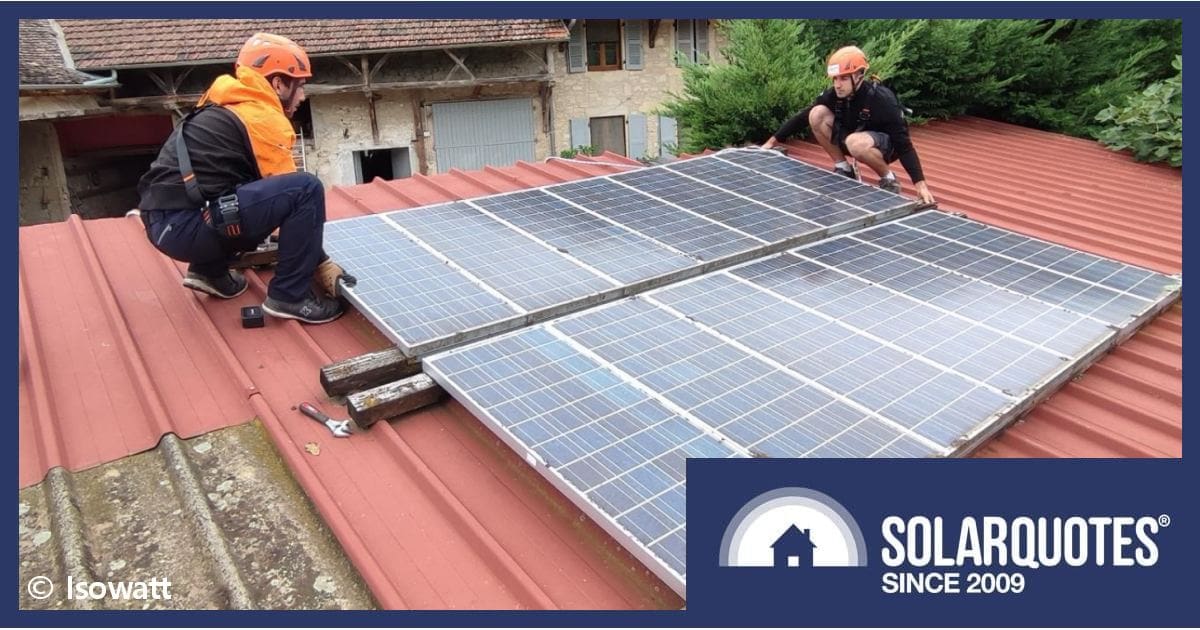 Millions of solar panels are expected to be chucked out as a result of the federal government’s home battery rebate. But do you really need to throw your system in the bin, and if so, what should you replace it with?
Millions of solar panels are expected to be chucked out as a result of the federal government’s home battery rebate. But do you really need to throw your system in the bin, and if so, what should you replace it with?
The buzz around Labor’s Cheaper Home Batteries Program was initially all about winning elections, but interest has now switched firmly to storing electrons.
The Smart Energy Council expects around 15 million solar panels will be thrown out as people upgrade their systems with the battery rebate.
But does getting a battery mean its time for an entire new solar system? Well, it’ll sound like a mealy-mouthed political answer but, really; it depends.
Even With The Rebate, Good Batteries Are Expensive
Though our promised new government incentive is creating incredible interest, you’ll still need a fair chunk of private investment to secure a good one.
The labour to install it is a significant chunk of the cost, no matter what size, so you don’t want to blow a limited government incentive on a disappointingly small battery.
Conversely, if your solar is small and you don’t have enough yield to fill the battery on an average day, the money spent may have an underwhelming rate of return.
To get the best return, your battery needs to be sized properly to fit your habits now, plus more to meet direct consumption and heat water.
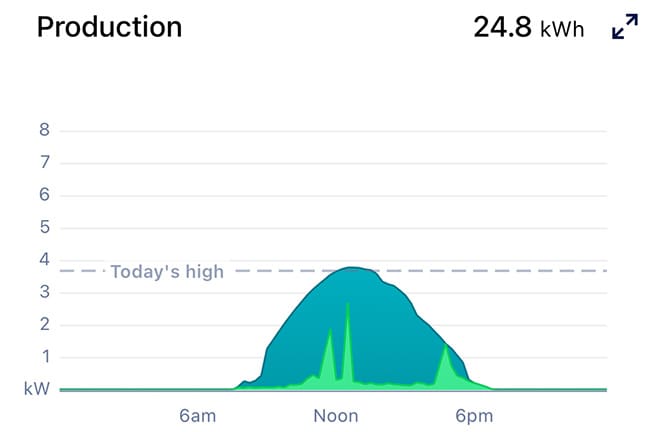
Solar monitoring data can provide insights to your current production and consumption, and in turn whether a battery is worth it. In this example, green is self consumption so there’s plenty of teal blue energy under the curve to store for later.
Mine Your Solar For Intel
If you have some monitoring on your existing solar system then it’s a veritable pot of gold that you or your installer can exploit for data.
Even the most basic solar inverter will have a counter for kilowatt hours produced. Divide that by the number days since it was installed to get an average daily yield. Take away the average daily export which appears on your power bill and the remainder is how much solar you’re self-consuming.
It’s difficult to tell how much of your billed consumption is overnight, but you’ll at least get a feel for the numbers.
For those with a retail “smart meter” you can contact your utility and they’re obliged by law to hand the data over. Plug that file into our calculator for a better result than the back of any envelope.
Pros And Cons To A Solar Upgrade
If your solar power system is old, there are still good reasons to leave it on the roof to continue its good work. Throwing things in the bin just because they’re not shiny enough is a curse on us all.
With an AC-coupled battery like Tesla Powerwall 2 or Sonnen for instance, your legacy system can be a perfectly good solar source.
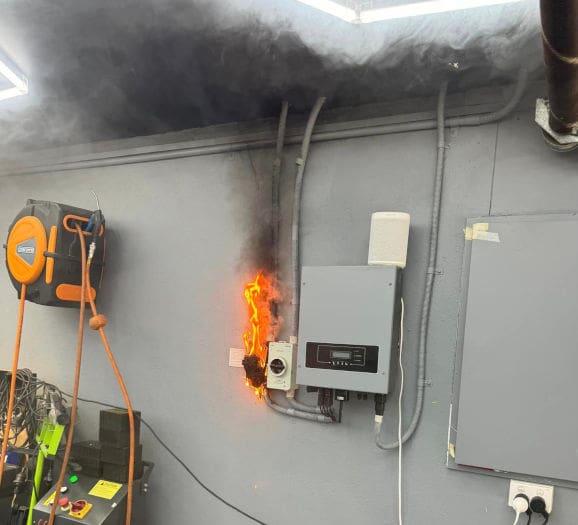
Inverters are more reliable than the isolator seen burning here, but age and quality is worth considering when looking at whether to upgrade.
If your solar power system is old there are some equally good reasons to replace it, not least of all the chance to get rid of the fire risk which is the rooftop isolator.
New solar comes with a fresh warranty, up-to-date monitoring and greater power density. And of course you can add more panels, because more solar is more. No matter the direction, anywhere they’ll fit is good.
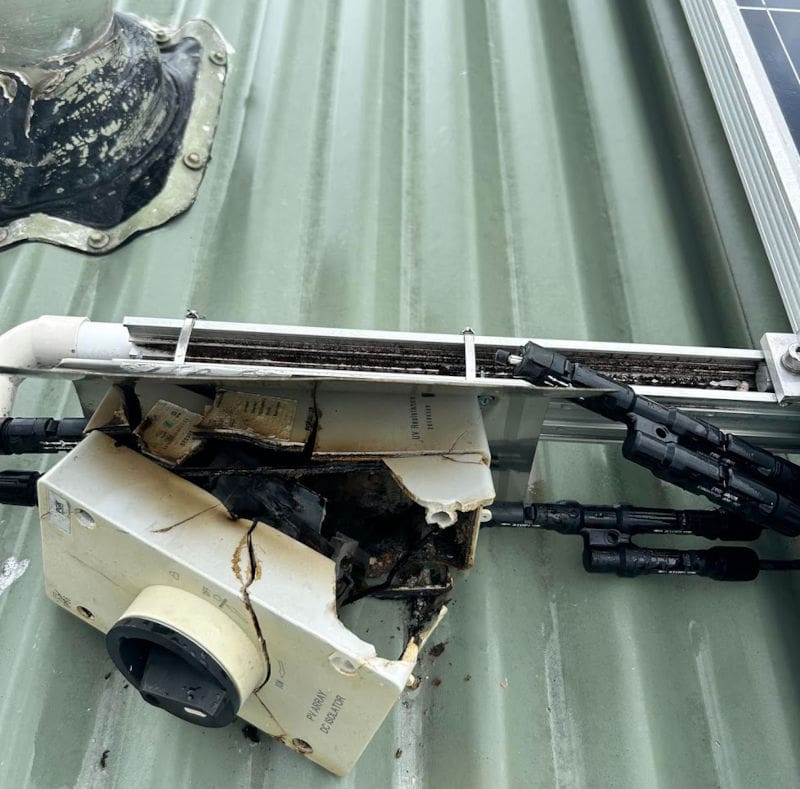
Roof Top Isolators are such a terrible idea they were largely written out of the rules. It only took us ten years to get rid of them.
Solar Arrays Can Be Kept
Assuming they’re good quality, well installed and pass electrical tests, your solar array can have some “minor repairs” in order to connect it to a new inverter.
Be aware though, some installers are not comfortable to offer a warranty on legacy solar. They deem it a risk to the new inverter and their reputation.
Electricians can be conservative but it’s not wrong to cite Australian Solar Standard AS5033 and point out the rules for wiring through the roof have moved on, so they’ll quote an entirely new, fully compliant, latest-specification system.
We’ll Lose Some Good Soldiers
Even if your solar isn’t terribly old, integrating new components and bringing it all up to current standards can be difficult.
If you’re in South Australia for instance, new equipment must meet current rules. There’s no grandfathering, and sadly, retro integration for flexible exports is likely impossible; unless perhaps you have a Fronius Snap inverter. Fronius take sustainability seriously, so they work hard to make their gear durable and flexible for the future.
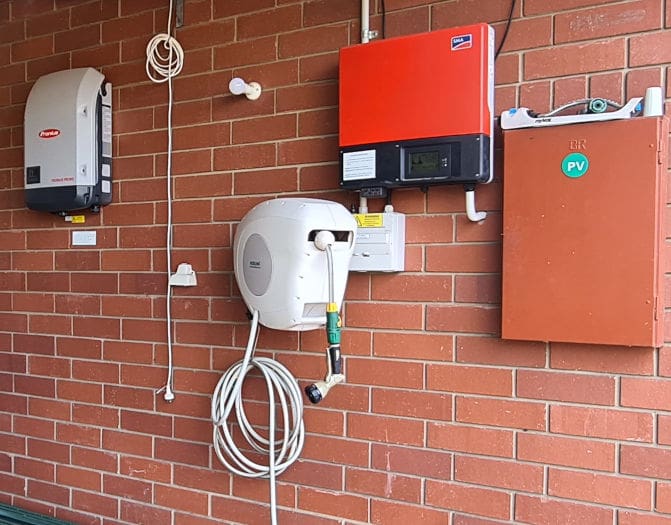
The grey Fronius unit can be updated for full flexible rules compliance in SA, QLD and soon NSW. Sadly the very robust red SMA unit is unlikely to be saved, unless maybe your electrician can develop a custom CatchControl solution to switch it off?
Hybrid Inverters Are The New Black
For more than a few reasons installers are quoting on new hybrid inverters capable of integrating with a battery.
- With rules yet to be finalised for the new battery incentive, most hybrids can be installed now with a battery simply added after July 1st.
- Hybrids can also be configured just like an AC coupled battery, with or without additional solar DC coupled straight to them for extra capacity and black start ability
- Many hybrids can control a legacy grid connect inverter, using frequency shift to control it during an outage (but without black start ability)
Going For Grunt
The most compelling reason to install a new inverter may be the outright capacity you can connect.
Some electricity distributors will only allow 10kW of inverter capacity per connection, so using Enphase as a sad example, a 5kW solar generator could only have a 5kW backup capacity and 5kWh battery.
Whereas Sungrow (under the same 10kW per phase connection limit) could have 10kW of inverter power (for great backup) 20kW of solar and 76kWh or storage.
Keeping your old inverter may hamstring your future plans.
Seamless Ecosystems
If you have monitoring with valuable history and you’d like to keep everything together and visible on one app, it’s worth keeping to a single brand. For instance, Sungrow can have a number of separate inverters on the same site all appear under the same monitoring.
Fronius have a great EV charger that will integrate seamlessly with smart solar charging and a hot water controller.
However if you’d like some annoying examples, Sungrow don’t presently offer an EV charger,1 Solar Edge don’t have an EV charger that’s OCPP compatible and without third party software, Tesla’s EV charger is dumb.
GoodWe have a nice EV charger but you’re best off using a Catch Control consumption meter to avoid connectivity problems.
Catch Control can sometimes stitch together a salad of different equipment, but in any case it’s a matter of having a great installer who understands the hardware they use and are willing to solve problems if they crop up.
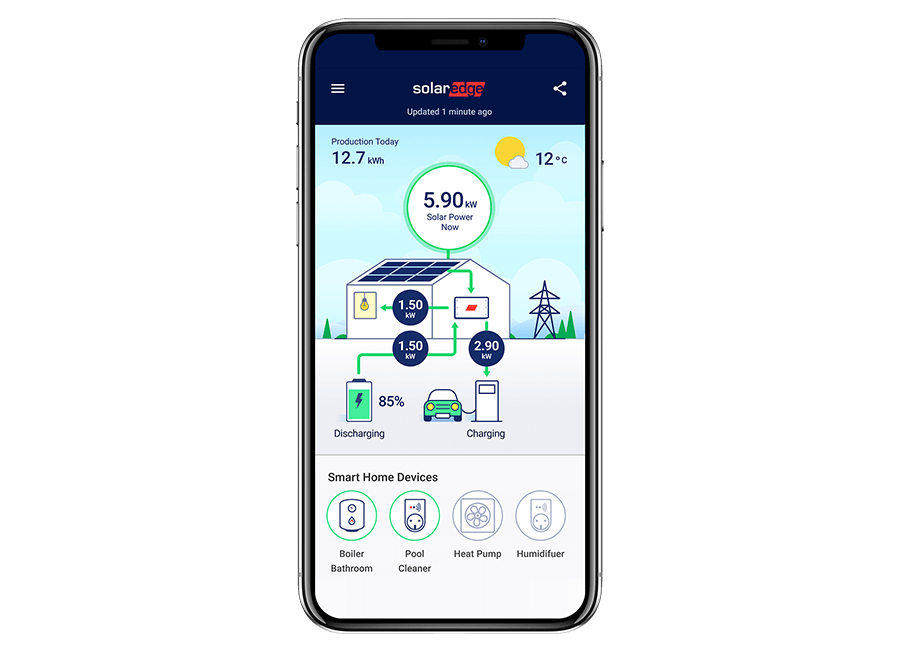
The MySolarEdgeSolar app, including battery and EV charger performance.
Efficiency Is King
You don’t need a special department of government to realise the cheapest kilowatt hour is the one you never needed to use in the first place.
As winter closes in and the sun hours wane, solar energy to power your house is more limited, while the occupants’ need for warmth and appetite for electricity knows no bounds.
Heat pumps, reverse cycle air conditioning, no matter what you call it, refrigeration can take heat from outside and put it wherever you like in a manner so efficient it’s like voodoo.
If you can keep the drafts out and the heat in, with gap sealing, window dressing and insulation your entire house will be more comfortable and cheaper to run.
Plan For Expansion
Adding solar, batteries or other electrification solutions can require more upgrades, so please consult our guides and Factually Answered Questions section.
For a guide on the best batteries to get under the rebate, take a look here, and for the best solar panels available in 2025, take a look at our video guide.
Footnotes
- We have wind of a Sungrow EV charger coming soon ↩

 RSS - Posts
RSS - Posts


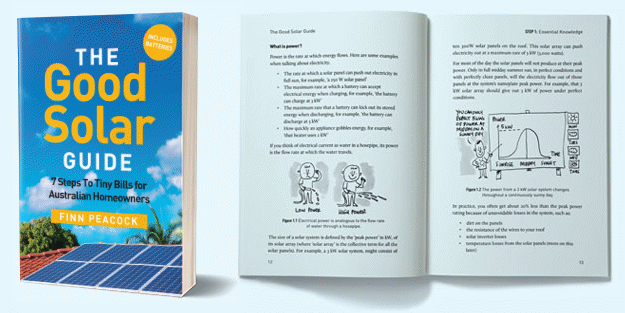
So can you get rooftop isolators removed easily? Or will contractors not want to touch any part of the solar installation?
This is outrageous. If there are silly rules requiring you to throw away a perfectly good solar system, those rules need to be changed.
The minister needs to be asked questions about his, and if he doesn’t act, needs to be publicly embarrassed. And this needs to happen now, not in three years’ time.
Is there really any point having so much solar on your roof if your bills are not large?
I have 6.16kw of panels which generates 2x our usage over the entire year.
Sure, in winter it won’t be able to charge a battery daily, but spending another 10k sounds like the wrong move when our power consumption (excluding supply charge) only costs 1k per year.
How about charging a battery from the grid when necessary during the day during cheap rates and consuming it during the evening peak? That seems like an economically wiser option to me than replacing my 6.16kw panels and spending 10k throwing them away replacing them.
I reckon I can reduce our consumption charge from 1k per year to $500 per year by buying a battery and using excess solar plus buying cheap grid power during the day and using it at night.
If I spent the same again and solar it would mean I just pump heaps more into the grid at peak times for no return.
Isn’t that the point of this, to shift consumption from peak?
Check out The Electric Viking, he recently had a video about that. I think he was saying that the Tesla Powerwall has the capacity to top up a solar battery to full from grid during cheap tariff periods.
This is what I do with my current system – I have 13kW of PV AC coupled (I kept my existing PV inverter+panels) to my new 24kWh battery (SigEn) and it’s set to charge to 100% each day by 2PM from a mixture of solar (if available) and grid for free (11AM-2PM free). Then use the battery for the remainder of the afternoon (if needed) and overnight ideally through till solar kicks in or 11AM the next morning. On good solar days the grid charging may not be needed, but on poor solar days it’s excellent
Hi Rodney, it’s fantastic to see how well you’ve configured your system to optimize free grid charging and solar. Smart move!
Just a heads-up — with newer Tesla Powerwall 3 models, you can now streamline your charging schedule even better with dynamic tariff responses. Many of our customers are seeing up to 30–40% more battery utilization using this method.”
Rest you can do due diligence by yourself too.
I’m in a similar situation Sam.
My existing system is similar size to yours, it’s only about 7 years old & probably has another 23 years of life left.
By changing the times I use various appliances, TV etc, , over the course of a year I achieve an average self consumption of around 60%+
Just to illustrate that:
ie: Solar Kwh Produced: = 100%
Less – self consumed Kwh = -60%
Net exported Kwh = -40%
Assuming my supplier charges (say) 33cents, per kwh, and my FIT is say 3c, I’m benefiting from my self-consumption as follows.
Initial saving benefit 33cents, less FIT not earned = – 3 cents = Net saving of 30 cents, per self-consumed kwh
Fortunately, my system had fully paid for itself just before FIT’s started to reduce.
There’s are minor tweaks you can do, depending on your family size.
eg… I replaced my 1200 watt microwave with a 700 watt one. That means that when solar output is low, I can still cook stuff for free. Takes longer though,
Nothing wrong with having two microwaves, using the smaller one when you only want to cook a small qty, or reheat your cocoa during winter.
The cost of smaller size microwaves is extremely low – I paid a mere $39 for one on special.
I’ve got induction coil hotplates on my stove as well and use those when needed
I’ve also got a stock standard HWS, which are vastly cheaper than solar heated HWS, plus you dont’ have a huge weight on a small portion of your roof either.
The more ‘sophisticated’ your system is, then the economic law of diminishing marginal returns usually comes into play & the net gain from each add-on becomes smaller and smaller.
“Outrageous” is a little harsh and blaming it on the Federal govt when it’s State govt legislation is silly. Especially when politicians have zero idea about the technical side of inverters. They just listen to the advice they’re given by the local power network so it’s really SAPN setting the rules in SA. The example used in the article of the SMA inverter is sadly over 15yo (I had one on my 2008 system). It wasn’t an issue when that inverter hit the Australian market as solar was very low penetration and oversupply and throttling was not needed. So replacing it is probably overdue. Most people won’t balk at replacing it. I had to anyway because it was too small for my current system. In any case the best way to go is a DC coupled hybrid system and all current ongrid hybrid inverters on the approved list meet the standards.
Great – but wow, it’s getting so darn complicated.
I have a very tired old underperforming 7kW system, (2010 vintage) which I’ve been nursing along, even replacing dead panels with 2nd hand, as I’m still on the old legacy FIT of 44c. Therefore I won’t be changing it in the short term or else I’ll kiss my FIT goodbye.
HOWEVER hopefully by the time the premium FIT is running out (mid 2027 here in QLD) I can replace my whole system, add a battery, and also HOPEFULLY installers will know all the good and bad and will be able to design and install a great system.
We live in interesting times. All I can say is : Thank God we’re NOT going nuclear!
“The Solar Bonus Scheme offering a 44 cent per kilowatt-hour feed-in tariff is not available to new customers.
If you currently receive this tariff rate (and maintain your eligibility) you will receive this rate until its expiry date on 1 July 2028.”
You’ve got 12 months longer than you thought! I’m still on it too but I only have a small 3kW system.
Its <$4000 worth of feed in if I limp the old system along until 2028. However a lot has changed since 2012. Smart meter coming next month (cant opt out anymore 🙁 ), 2 x EV's and teenage kids! Time to go all in with this subsidy!
That 7kW system would have cost a pretty penny back in 2010? We did the most we could afford but it was worth it. Haven't had a significant bill since (excluding the EV's)
Interested to know where Enphase systems fit in all of this. I have 10kw on my roof and I think it’s working fine. Keen to get a battery – there seem to be 3 options for AC coupled scenarios:
– Powerwall 3 (but Musk, no 3 phase backup, and reports of poor performance/strange calibration behaviour)
– Sigenergy – impressive tech (full 3 phase backup) but questions over longevity of brand and support (and quality of components from a recent YouTube review by MC Electrical)
– Enphase 5p battery – seems fine, on the expensive side, and no 3 phase backup (although Enphase has just released a 3 phase battery in Europe called FlexPhase)
Have I missed something?
I have enphase on the roof supported by 2 X Powerwall 2s. Seems to be working Ok.
Have had PW3 for 7 months…No issues. It did do a battery calibration recently. It drains the battery then recharges it. I could go off grid but don’t need to happy to pay connection fee. It recharges the 2 x EVs on solar which I do. Remember the unit gets regular updates, (inbuilt inverter/battery combo)
I understood that all of SA will be given the opportunity to install more PV when the network upgrades are completed as planned. I would like to incorporate batteries, and extra solar to carry through the winter months, (and cover for grid blackouts) yet not lose the advantage of the legacy exporting option for our significant summer surpluses. Even though the FIT has diminished, the annual export still almost covers our annual supply charge, so we are happy to stay connected to grid. Up to now the cost of batteries added to a grid connect system does not justify the expense, but with the new subsidy on batteries, and if we can also get the STC on additional panels, then it might be cost effective to stay grid connected. So really it is a matter of,…. Are off-grid batteries to be subsidised, with extra pv and STCs applied,…. and can the house run predominantly on the “new “offgrid” battery, but keep the existing inverters and export options and add capacity.
Thanks for this article, it raises some important issues for people like me with an existing solar set-up, who are now thinking of adding a battery. We have a system installed in 2018 consisting of 18 x LG panels and a SolarEdge inverter (upgraded via a warranty claim since installation to a HD Wave model).
I sought quotes through this website for battery installation, one of which came back as installing a Goodwe battery and hybrid inverter. I checked in via a Facebook group (Australian Solar Power and Battery Storage Q&A) for thoughts on Goodwe batteries, and the responses alerted me to things like the fact that optimisers installed on our current panel would likely have to be removed if we installed Goodwe battery and inverter.
So there are probably heaps of things it is important to understand if looking to add a battery to an existing system – hopefully articles like this will help with that.
If you already have SolarEdge, it’s a wiser option to find a SolarEdge installer to get quotes from. Or, get the original installer to pull together a quote for the upgrade.
SolarEdge is a premium service – ie complicated and expensive, so the number of installers willing to deal with the install is limited to those with the spare time and expertise.
That said, the options are more restrictive because they don’t allow for variable hybrid technology/ battery storage options- you get what SolarEdge has to offer. Which is their own battery and EV charging system integrated with their hybrid inverter system. In that case, you can’t especially compare value or performance- it is what it is.
Making the SE work like the Sigenergy, Goodwe or the Powerwall 3 is not likely to make any sense for your existing install.
Ripping out the SE to swap in a Chinese Inverter is bound with all of those install and compliance issues the new installer won’t even consider or have solutions for.
Hi Toliman,
You’re correct about the complexity and specialisation of Solar Edge installers.
There are unique capabilities but also limitations.
However as I understand it the Solar Edge car charger isn’t OCPP compatible and so it can’t be used in South Australia, and shouldn’t be considered anywhere else where flexible exports are slated to come soon… ie the rest of the country.
Most customers I’ve spoken to won’t buy Solar Edge once they’ve learnt the company is headquartered in Israel.
The claim that the SolarEdge car charger is not OCPP compatible is incorrect. According to SolarEdge’s own installer documentation, the device connects to an OCPP server to provide consumption data and can generate charging reports. Independent Australian reviews also confirm the SolarEdge EV charger is OCPP compatible and can participate in solar smart charging
Hi Jeremy,
Solar Edge isn’t on the list so it can’t be installed in South Australia.
Tesla faced the same problem but they got it sorted.
So the SolarEdge car charger is OCPP compatible but not registered in South Australia?
I have a SolarEdge car charger on order (as my system is SolarEdge) but, as I am in WA, this shouldn’t cause me any problems I guess
Thanks for your thoughts on that. We have looked into a SolarEdge-based upgrade to install one of their batteries and upgrade to a new SolarEdge hybrid inverter. I’d prefer an LFP battery if possible and I like the modular/stackable of some other brands’ batteries, but maybe we are kind of locked in now to SolarEdge. I think I saw that they have released a new battery which will be on sale later this year or next in the US – can’t recall if it’s LFP but I think it is modular/stackable. We had our current system installed in 2018, we were not thinking then about how that might position us for future battery upgrades – it just seemed a reasonable option at the time. We have had to replace our inverter twice in the interim, most recently in August last year. We are now running a HD Wave inverter.
Thanks for the feedback Patrick,
SolarEdge warranty has been a sore point for some installers too. I believe they included a fire extiguisher inside the batteries at first but they don’t use them now.
Sorry, I’m unsure what this is intended to mean…
Going For Grunt
The most compelling reason to install a new inverter may be the outright capacity you can connect.
Some electricity distributors will only allow 10kW of inverter capacity per connection, so using Enphase as a sad example, a 5kW solar generator could only have a 5kW backup capacity and 5kWh battery.
Whereas Sungrow (under the same 10kW per phase connection limit) could have 10kW of inverter power (for great backup) 20kW of solar and 76kWh or storage.
Keeping your old inverter may hamstring your future plans.